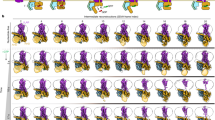Abstract
Diffuse X-ray scattering from protein crystals provides information about molecular flexibility and packing irregularities1–4. Here we analyse diffraction patterns from insulin crystals that show two types of scattering related to disorder: very diffuse, liquid-like diffraction, and haloes around the Bragg reflections. The haloes are due to coupled displacements of neighbouring molecules in the lattice, and the very diffuse scattering results from variations in atomic positions that are only locally correlated within each molecule. The measured intensity was digitally separated into three components: the Bragg reflections and associated haloes; the water and Compton scattering; and the scattering attributed to internal protein movements. We extend methods used to analyse disorder in membrane structures5–7 to simulate the diffuse scattering from crystalline insulin in terms of (1) the Patterson (autocorrelation) function of the ideal, ordered crystal structure, (2) the root-mean-square (r.m.s.) amplitude of the atomic movements, and (3) the mean distance over which these displacements are coupled. Move-ments of the atoms within the molecules, with r.m.s. amplitudes of 0.4–0.45 Å, appear to be coupled over a range of ~6 Å, as in a liquid. These locally coupled movements account for most of the disorder in the crystal. Also, the protein molecules, as a whole, jiggle in the lattice with r.m.s. amplitudes of ~0.25 Å that appear to be significantly correlated only between nearest neighbours.
This is a preview of subscription content, access via your institution
Access options
Subscribe to this journal
Receive 51 print issues and online access
$199.00 per year
only $3.90 per issue
Buy this article
- Purchase on Springer Link
- Instant access to full article PDF
Prices may be subject to local taxes which are calculated during checkout
Similar content being viewed by others
References
Phillips, G. N., Fillers, J. P. & Cohen, C. Biophys. J. 32, 485–502 (1980).
Boylan D. & Phillips, G. N. Biophys. J. 49, 76–78 (1986).
Doucet, J. & Benoit, J. P. Nature 325, 643–646 (1987).
Artymiuk, P. Nature 325, 575–576 (1987).
Li, J. thesis, Harvard Univ. (1978).
Maulik, S., Caspar, D. L. D., Phillips, W. C. & Goodenough, D. A. Biophys. J. 49, 342a (1986).
Maulik, S. thesis, Brandeis Univ. (1986).
Caspar, D. L. D. & Holmes, K. C. J. Molec. Biol. 46, 99–133 (1969).
Debye, P. ann. d. Physik 43, 49–95 (1914); The Collected Papers of Peter J. W. Debye (Interscience, New York 1954).
Waller, I. Z. Phys. 17, 398–408 (1923).
James, R. W. The Optical Principles of the Diffraction of X-rays (Cornell University Press, 1965).
Amoros, J. L. & Amoros, M. Molecular Crystals: Their Transforms and Diffuse Scattering. (Wiley New York, 1968).
Adams, M. J. et al. Nature 224, 491–495 (1969).
Compton, A. H. & Allison, S. K. X-rays in Theory and Experiment second edn (Van Nostrand, New York 1935).
Salunke, D. M., Veerapandian, B., Kodandapani, R. & Vijayan, M. Acta cryslallogr. B41, 431–436 (1985).
Narten, A. H. Oak Ridge National Laboratory Report No. 4578 (1970).
Sakabe, N., Sakabe, K. & Sasaki, K. Proc. int. Symp. Biomolec. Struct. Interactions, Suppl. J. Biosci. Vol. 8 numbers 1 and 2, 45–55 (1985).
Wonacott, A. J., Brook, P. Imperial College Rotation Film Scanning Package (1984).
Bernstein, T. F. et al. J. Molec. Biol. 112, 535–42 (1977).
Dodson, E. J., Dodson, G. G. Hodgkin, D. C. & Reynolds C. D. Can. J. Biochem. 57, 469–479 (1979).
Murray, C. A. & Van Winkle, D. H. Phys. Rev. Lett. 58, 1200–1203 (1987).
Debye P., Ann. d. Physik 39, 789–839 (1912).
Morozov, V. N. & Morozova, T. Y. A. J. theor. Biol. 121, 73–88 (1986).
Kalata, K. Meth. Enzym. 114, 486–510 (1985).
Karplus, M. & McCammon, J. A. CRC crit. Rev. Biochem 9, 293–349 (1981).
McCammon, J. A., Gelin, B. R. & Karplus, M. Nature 267, 585–590 (1977).
Levitt, M., Sander, C. & Stern, P. J. molec. Biol. 181, 423–447 (1985).
Ramanadham, M., Sieker, L. C. Jensen, L. H. & Birknes, B. J. Acta Crystallogr. A37 C-33 (1981).
Sternberg, M. J., Grace, O. E. P. & Phillips, D. C. J. molec. Biol. 130, 231–253 (1979).
Author information
Authors and Affiliations
Rights and permissions
About this article
Cite this article
Caspar, D., Clarage, J., Salunke, D. et al. Liquid-like movements in crystalline insulin. Nature 332, 659–662 (1988). https://doi.org/10.1038/332659a0
Received:
Accepted:
Issue Date:
DOI: https://doi.org/10.1038/332659a0
This article is cited by
-
Diffuse X-ray scattering from correlated motions in a protein crystal
Nature Communications (2020)
-
Macromolecular diffractive imaging using imperfect crystals
Nature (2016)
-
Visualizing networks of mobility in proteins
Nature Methods (2013)
-
Ultrafast X-ray experiments on structural changes in single crystals of polar molecules
Applied Physics A (2009)
-
NMR evidence for slow collective motions in cyanometmyoglobin
Nature Structural Biology (1997)
Comments
By submitting a comment you agree to abide by our Terms and Community Guidelines. If you find something abusive or that does not comply with our terms or guidelines please flag it as inappropriate.



